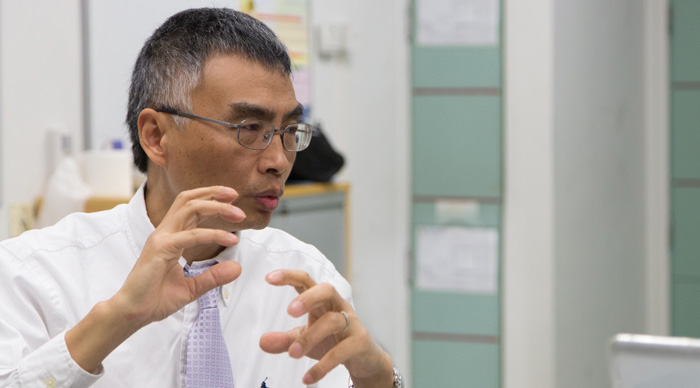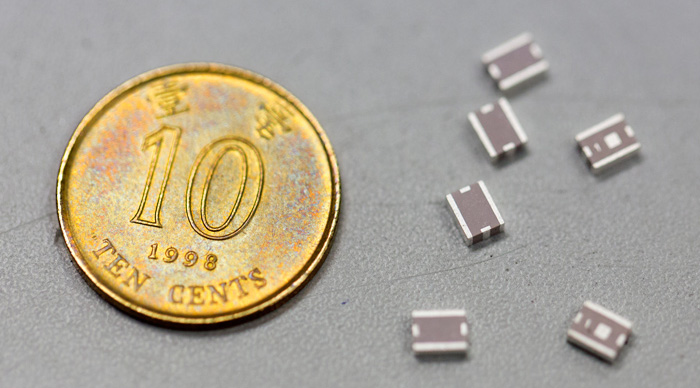Dear readers, With the launch of e-newsletter CUHK in Focus, CUHKUPDates has retired and this site will no longer be updated. To stay abreast of the University’s latest news, please go to https://focus.cuhk.edu.hk. Thank you.
Working on the Phones of the Future: Unique lab allows insight into efficient data transmission

Prof. Wu Ke-li
Department of Electronic Engineering
As he raises his hands, surrounded by foam cones and antennas, it looks like Prof. Wu Ke-li is going to be sent into the future. There's a circle of sensors around him, and foam pyramids that are designed to absorb any electromagnetic waves sent out of them, to give him a reading that appears as if a mobile-phone signal goes on forever. He looks like Leonardo da Vinci's Vitruvian Man.
Professor Wu is working in the only facility of its kind on an academic campus in the world, a radio-frequency radiation research lab, which opened at CUHK in 2006. As director of the lab, his insights give us a glimpse of the future for mobile-phone use, and how we interact with each other. Through a better understanding of the antennas in a smart phone, Professor Wu hopes to improve our way of communicating with each other.

Each of our smartphones nowadays has around seven antennas, if not more. Each generation of phone and system – 3G, 4G, WiFi, Bluetooth – adds to the phone's complexity. The issue is that every antenna in a phone radiates electromagnetic waves that are picked up by the other antennas working in the frequencies very close together or even overlap. That causes interference that hinders the function of the phone.
Professor Wu and his graduate students have discovered a way of counteracting that interference by a passive circuit. He uses some of the power emitting from the phone's transformers to "eat up" the opposite signal that creates the unwanted interference. Instead of blocking a signal – the current approach – Professor Wu's strategy turns the signal on itself, creating a negative path for the same amount of signal to cancel the interference from the air.
Perfecting smart-phone service is bound to be a key market. Last year, smartphone sales outdid sales of regular phones for the first time, with 968 million smartphones sold, 54 per cent of the global mobile-phone total, according to the consulting group Gartner, and an increase of 54 per cent over the previous year.
If you're using an iPhone, Apple's operating system has a distinctive pattern of its own. You may not notice it, but the phone will not be downloading data while you are talking. That's because the two antennas involved are separated, with one blocked from the other when they are operating.

Any other phone has its own way of counteracting the interference caused by the different antennas. That slows down data transmission. Professor Wu's research group invented what's called the Coupled Resonator Decoupling Network technology, which can almost negate any unwanted interference signal.
"This is a very well-known outstanding problem in the industry," Professor Wu says. "We can reduce this interference by hundreds times."
Professor Wu, a professor in CUHK's Department of Electronic Engineering, hopes that the same results can lead to the formation of a spin-off company that fosters the technology for commercial use. The University holds the intellectual property to the now-patented decoupling technology.
Professor Wu believes the fight for the radio signal interference among the very crowded frequency bands in a smart phone will be crucial in the years ahead. "What is worth the most money in this century is talented people, and the second is frequency spectrum," he says with a laugh.
It was Professor Wu's graduate student Zhao Luyu who first noticed the ability to decouple the signals using a simple network. "At first I didn't believe it happened," Zhao recalls, and wasn't too sure of its significance. Professor Wu drew on his years of experience in both the corporate world and academia to realize how significant the discovery could be for smart phone makers.
Part of their research is sponsored by the private sector, and Professor Wu works very closely with the telecommunications industry in China. He feels that is a major advantage for Hong Kong-based researchers, who have electronics manufacturers close to them over the border from Hong Kong. "We can get feedback from the industry, what kind of problems they want to solve," he says.
Professor Wu wants to figure out how his research can be used in smart phones. One goal is to be able to mass-produce these already-tiny components – Professor Wu's group has developed the component in a multilayer ceramic part that is only 1 cubic millimeter – in even-smaller sizes.

"At this stage, it is just a start," Professor Wu says. "We can apply this new technology to various interference problems in a smart phone and wireless base stations, where the interference between co-existing systems in close frequency bands can be reduced by thousands time."
By Alex Frew McMillan
This article was originally published on CUHK Homepage in Apr 2014.